
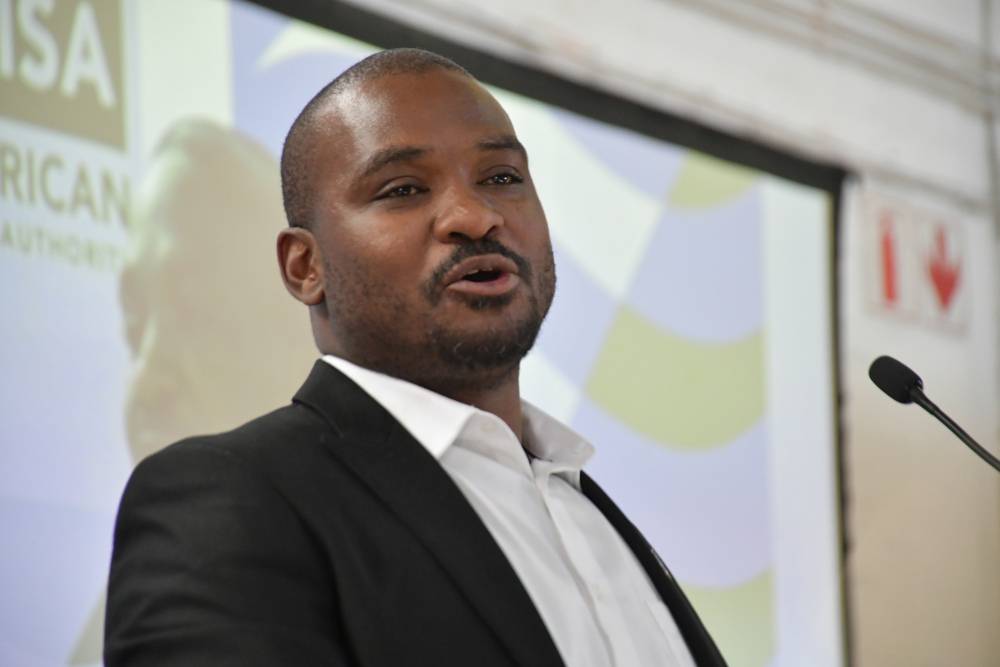
Contents
- SAMSA’s Captain Thobela Gqabu appointed to the top leadership of IOMOU on Port State Control
- Securing South Africa’s natural environment from oil spills
- Keeping a constant eye on wide blue ocean horizons
- Seafarers education and training; South Africa and IMO Whitelist status
SAMSA’s Captain Thobela Gqabu appointed to the top leadership of the IOMOU on Port State Control
South Africa also rises to the helm of the Djibouti Code of Conduct-Jeddah Amendment over the next two years
In the year 2023, marking of its 25th anniversary, the South African Maritime Safety Authority (SAMSA) has had the pleasure of celebrating the good news of the appointment of one of its high-ranking officers, Captain Tobela Gqabu, to the helm of one of the world’s most important maritime regional bodies, the Indian Ocean Memorandum of Understanding (IOMOU) on Port State Control in the Indian Ocean Region.
The development occurred within weeks of South Africa also being elected to the chairpersonship of the Djibouti Code of Conduct-Jeddah Amendment Steering Committee, during the International Maritime Organisation (IMO) supported body’s three-day high-level meeting held in Cape Town in October.
In Mahe, Seychelles, in September 2023, nominated by Australia, seconded by Mozambique and Madagascar, and supported by all other member countries including Tanzania, Mauritius, Sri Lanka, Iran, Kenya, Yemen, France, Bangladesh, Comoros, Seychelles and Myanmar, the IOMOU body elected Capt. Gqabu as the Chair of its Committee for the next three years.
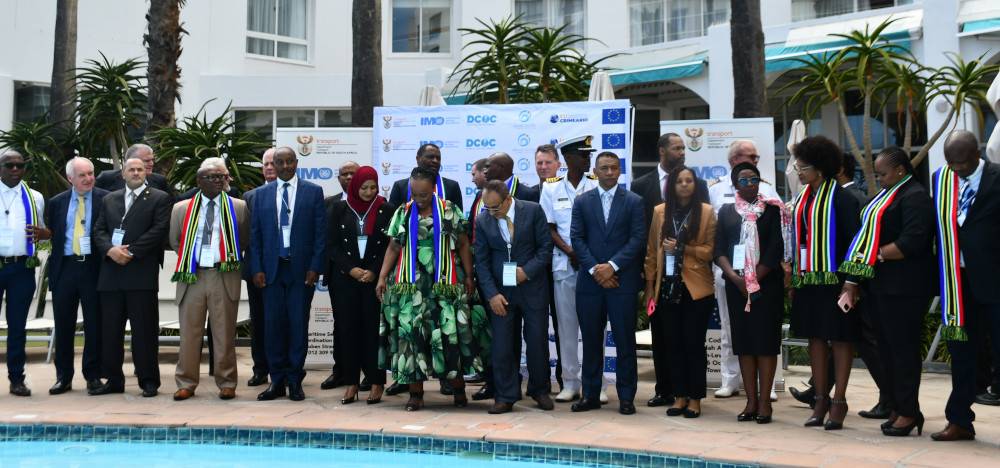
In taking over the leadership of the organisation, Capt. Gqabu succeeded Beatrice Nyamoita, Deputy Director, Shipping Maritime, State Department of Transport, Kenya, who was the Chair of the IOMOU PSC Committee for the past six years. Capt. Gqabu held the position of Vice Chair.
The Indian Ocean MOU, established in 1997 in the Indian Ocean Region, is an intergovernmental organisation on port State control (PSC), recognised with full support also by the IMO, a United Nations (UN) Special Agency. The IOMOU has a membership of 20 countries (Ethiopia is an observer country) and 12 observer organisations.
As of 2023, 20 countries are parties to the memorandum. These are: Australia, Bangladesh, Comoros, Eritrea, France (La Reunion Island), India, Iran, Kenya, Madagascar, Maldives, Mauritius, Mozambique, Myanmar, Oman, Seychelles, South Africa, Sri Lanka, Sudan, Tanzania and Yemen. The Authority of the State of Qatar will become the 21st member of the IOMOU after completion of the ratification process.
In its early stages, there were only a few observers for the IOMOU, but in 2023, the total number of observers has risen to 12. Among them are Ethiopia (land-locked country), Black Sea MoU, Caribbean MoU, Mediterranean MoU, Paris MoU, Riyadh MoU, Tokyo MoU, West & Central Africa MoU, IMO, International Labour Organization (ILO), United State Coast Guard and Equasis.
On receipt of the news of his election as the Chair of the IOMOU PSC Committee in September 2023, both management and the staff at the SAMSA were elated, with then Acting Chief Executive Officer (Chief Financial Officer) Zamachonco Chonco describing the development as “great news and definitely needed for SAMSA and South Africa at large”. SAMSA Deputy Chief Operations Officer (DCOO), Capt. Vernon Keller felt strongly that it was “indeed … a win for South Africa”.
The news came barely as a surprise though to SAMSA and Gqabu. This was evident in further remarks by Capt. Keller, who in his congratulatory comments pointed out that: “Your hard work has paid off!”
In fact, Capt. Gqabu’s rise to the position of the Chair of the IOMOU PSC Committee came on the back of several years of his active and sincere involvement with the body, and by putting in six years of hard work when he served as Vice Chair.
Capt. Gqabu presently holds the position of the Regional Manager for the Eastern Region, SAMSA in the province of KwaZulu-Natal. Based in Durban, his region has the country’s busiest ports — Richards Bay and Durban. His 25 years of industry experience (which includes 11 years on ships at sea, five years as a ship surveyor and six years as the Principal Officer) is regularly tested and extended, drawing attention to his academic knowledge through the International Chamber of Shipping (ICS).
Capt. Gqabu is known as one of South Africa’s young corps, having the competency of Master Mariner and related requisite skills in international shipping. He is one of the four regional managers at SAMSA, responsible for management of day-to-day operations of the entity along South Africa’s coastline of around 3 200km, and encompassing an Exclusive Economic Zone (EEZ) of approximately 1.5 million square kilometres.
Capt. Gqabu has the singular honour of having become the first Lawhill Maritime Centre (Simonstown) student to qualify as a Master Mariner. He also received national recognition after being listed among the Mail & Guardian’s 2016 cohort of 200 Young South Africans. He represents SAMSA on various international fora including the IOMOU on Port State Control.
Capt. Gqabu will hold the position of the Chair of the PSC Committee of the IOMOU for the next three years.
One of the IOMOU’s expectations, during his tenure as the Chair of the Committee, is the number of maritime authorities supporting the IMO-sponsored Cape Town Agreement 2012 (CTA 12), which will increase much faster among the IOMOU member countries. “It is a long-time pending IMO instrument,” he said.
The Cape Town Agreement, established in 2012 according to the IMO, provides standards on the design, construction and equipment of fishing vessels. It includes regulations designed to protect the safety of crews and observers and provide a level playing field for the industry.
The IMO has stated that the instrument will also contribute to the battle against Illegal, Unreported and Unregulated (IUU) fishing. However, to enter into force, at least 22 states, with over 3 600 fishing vessels of 24m in length, must sign the treaty. Although many member states have already ratified the instrument, the treaty needs more members with more fishing vessels to reach the target number of 3 600 fishing vessels.
For good news and progress for the IOMOU, in the meantime, membership among the eight Indian Ocean rim African countries is also due to increase. Somalia is most likely to become the earliest to join as the sixth African country, confirmed Capt. Gqabu.
“As reported by the IMO, the Authority of Somalia is also in the process of ratification of the IOMOU. After ratification of the IOMOU on PSC in the Indian Ocean Region, Somalia also will be able to share its valuable comments and support to the MoU,” said Capt. Gqabu.
South African has few domestic flagged ships, except for fishing vessels, yet plays a great part in pursuance of the IOMOU goals. Says Capt. Gqabu: “Member Authorities of the IOMOU Committee have elected me as the Chair on a proposal by Australia. I was Vice Chair for the past six years. That experience will help me to progress.
“In addition, the IOMoU is about Port State Control (PSC) inspection of foreign ships in national ports, to verify that the condition of ships and their equipment comply with the requirements of international regulations, and to see that ships are manned and operated in compliance with the internationally in force IMO instruments, to ensure maritime safety, security, prevent maritime pollution and protect the maritime environment.”
Chairing the DCoC-Jeddah Amendment Steering Committee
Meanwhile, within weeks of Capt. Gqabu being elevated to the leadership of the IMOU on Port State Control, on 24-26 October 2023, in Cape Town, South Africa was further graciously entrusted with chairpersonship of the Djibouti Code of Conduct (DCoC)-Jeddah Amendment Steering Committee, for a period of two years.
The DCoC is a product that serves as a forum of countries in the Western Indian Ocean and Gulf of Aden region working in partnership, cooperation, and collaboration in the suppression and possible elimination of various crimes against ships in the area.
Founded and adopted in 2009 at the encouragement of the United Nations and the IMO, signatory States to the DCoC include the Comoros, Djibouti, Egypt, Eritrea, Ethiopia, France, Jordan, Kenya, Madagascar, Maldives, Mozambique, Oman, Saudi Arabia, Seychelles, Somalia, Sudan, United Arab Emirates, The United Republic of Tanzania, Yemen and South Africa, which joined in 2012.
The Jeddah Amendment, enforced by the DCoC since 2017, has the aim of expanding measures for suppressing a range of illicit activities including Illegal, Unreported and Unregulated (IUU) fishing, piracy, arms trafficking, trafficking in narcotics, illegal trade in wildlife, illegal oil bunkering, crude oil theft, human trafficking, human smuggling and the illegal dumping of toxic waste.
According to the committee, the governance framework of Djibouti Code of Conduct comprises a Steering Committee, a Working Group on Information Sharing and a Working Group on Capacity Building Coordination.
The DCoC key objectives include:
protection of the population of DCoC signatory States from illegal and dangerous activity, including serious organised crime and terrorism,
development of maritime governance capacity and capability of DCoC signatory States including promoting the enhancement of regional operational coordination, cooperation, and communication, as well as
protecting DCoC signatory States, their citizens, and economies by supporting the safety and security of ports and offshore installations, other infrastructure and DCoC signatory States’ flagged passenger and cargo ships.
South Africa, through the Department of Transport, will assist and guide the DCoC Member States during its Steering Committee chairpersonship tenure, over the next two years in the development of a maritime security strategy expressly reflective of: “…a collective effort to identify how Signatory States can work together, both nationally and as a region, for the benefit of all,” said the Cape Town 6th level committee.
Securing South Africa’s natural environment from oil spills
The Interim IMOrg helps to prepare the country for a variety of maritime incidents
The Interim Incident Management Organisation (IMOrg), a virtual organisation chaired by the Department of Transport with SAMSA as the co-chair and secretariat, is South Africa’s preparedness forum for joint government and industry response to oil spills within South Africa’s exclusive economic zone (EEZ).
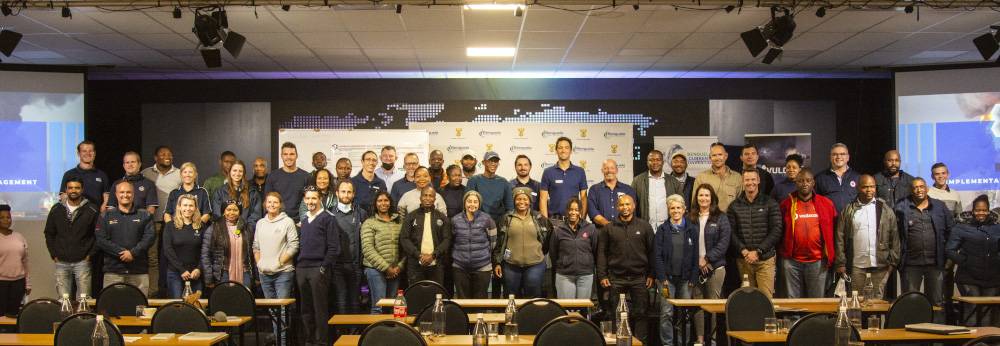
It was launched in 2017, as a deliverable of the Operation Phakisa Oil and gas laboratory B1 initiative for “joint government – industry emergency drills”. IMOrg’s membership is drawn broadly from across various sectors of society inclusive of State departments, private sector industries as well as non-governmental institutions.
According to Captain Ravi Naicker, SAMSA Senior Manager and co-chair, and Project Manager of the Interim IMOrg, the structure will remain “interim,” until the Marine Oil Pollution preparedness response cooperation Bill is promulgated. The Bill is currently following Parliamentary processes for enactment. Public comments were submitted in August 2023.
Capt. Naicker says the current focus of the Interim IMOrg is on oil spills but in the future, it will ramp up to an all-hazard approach. He says, among other issues, the structure identifies primary roles of government and industry contributing towards the preparedness of the country with effective and efficient management of maritime incidents such as oil spills offshore.
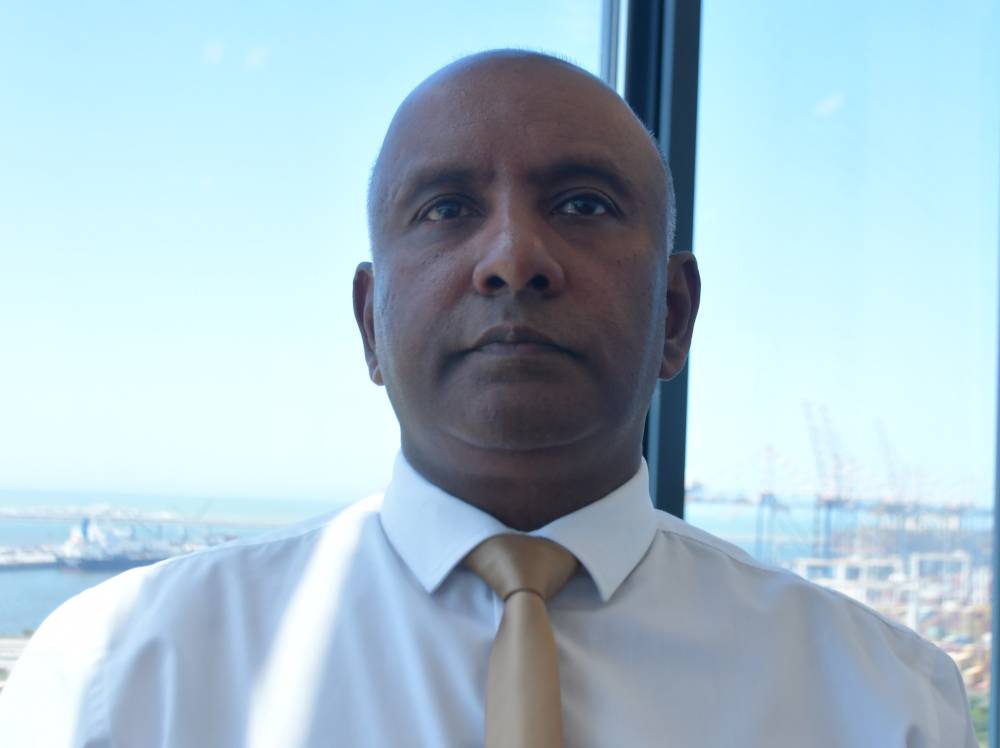
Its specific objective involves the staging of joint emergency response drills to prepare the country for a variety of incidents and uses the Incident Management System (IMS) as its preferred response model “for effective and efficient use and deployment of the available resources, both human and equipment, for all types of incidents, including marine pollution”.
At-sea exercises:
From a project management perspective, according to Capt. Naicker, the at-sea exercises conducted periodically at selected locations across the coastline are important for the country’s sharpened state of readiness. From a South African perspective, according to the IMOrg, he says the logic behind the initiative is simple. Increased activity on the South African coastline of over 3 900km (including the coastline around the Prince Edwards Islands) demands the country to be ready to attend to any emergency that might occur along its pristine coast.
Current estimates of shipping traffic in the three oceans around South Africa are that as many as 30 000 vessels sail through here annually, with many of them laden with an excess of 30-million deadweight-tonnage of crude oil.
“A large-scale oil spill could potentially have catastrophic consequences on the marine environment. There is also offshore oil and gas exploration and bunkering activities, therefore South Africa needs to ensure that while it seeks economic stability and prosperity, it also ensures the protection of its natural biodiversity.
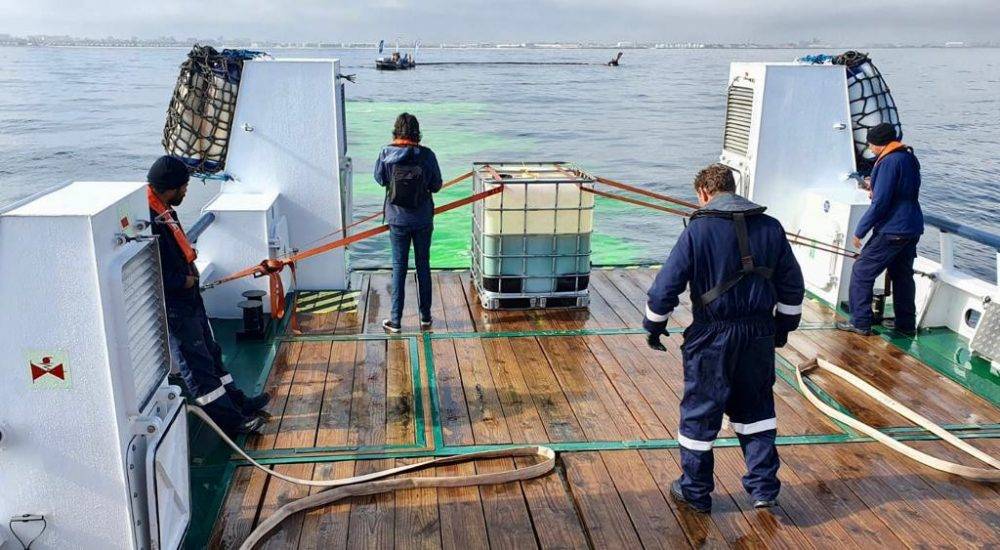
“To this end South Africa has adopted international best practice in incident management and is proactively and continuously preparing to manage marine pollution incidents effectively, ensuring that the appropriate resources and stakeholders are mobilised quickly – and important and timeous decisions made,” says Capt. Naicker.
The IMOrg will arrange and conduct the following:
- Tabletop exercises – Table top exercises involve discussion of simulated scenarios by key personnel in an informal setting.
- Drills – A drill is a coordinated, supervised activity usually employed to validate a specific function or capability in a single organisation or agency.
- Functional exercises – Functional exercises are designed to validate and evaluate capabilities, multiple functions and/or sub-functions, or interdependent groups of functions.
- Full-scale exercises – Full-scale exercises are typically the most complex and resource-intensive type of exercise. They may involve multiple agencies, organisations and jurisdictions, and can validate many facets of preparedness.
Among the IMOrg guiding tools with the exercise is the country’s National Oil Spill Contingency Plan (NOSCP) and annexes that include the wildlife response plan and the IMS manual and handbook.
Capt. Vernon Keller, a deputy Chief Operations Officer at SAMSA, adds: “The training exercises that we conduct periodically and consistently provide an opportunity for South Africa to build capacity necessary to effectively respond in cases of incidents and disasters and the IMOrg’s efforts to institutionalise the IMS response model.
“To have an effective response, it is critical that the responders are fully trained and certified competent on the Incident Management System. Additionally, it becomes important that the country mobilise resources and conduct exercises to assess its response in terms of efficiency and effectiveness.”
Incident Management System (IMS)
Training on the globally acclaimed and International Maritime Organisation (IMO) approved Incident Management System (IMS) is conducted by specialists in the field, consisting of three modules: IMS 100, 200 and 300, featuring a desk-top classroom-type engagement of delegates.
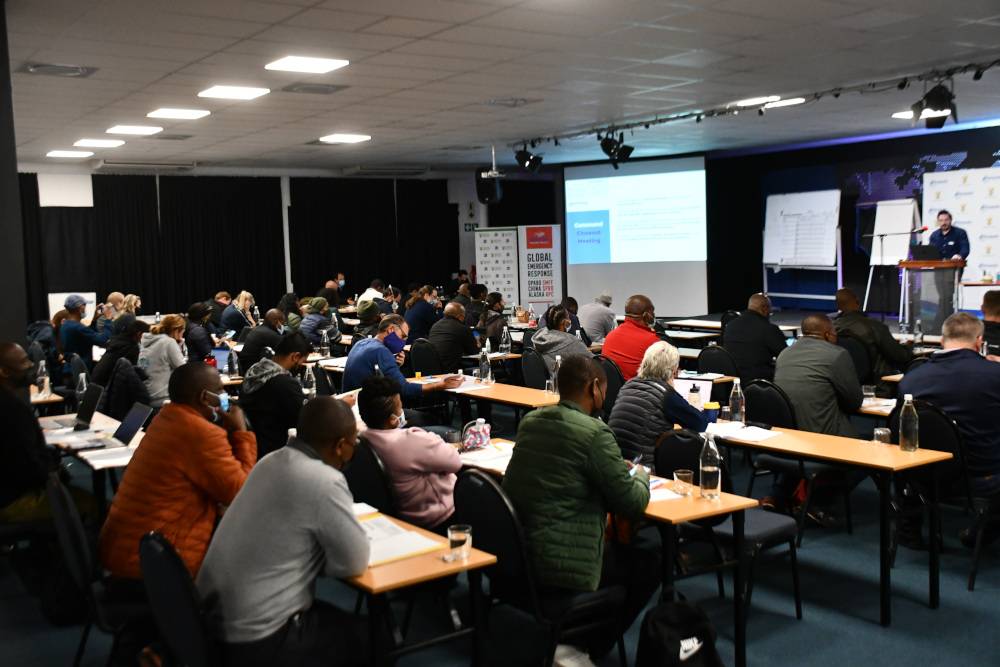
Many of the countries on the continent and small island States in the Western Indian Ocean have also adopted IMS as a response model.
The institutionalisation of IMS is one of the key objectives of the IMOrg. Thus far five national exercises have been conducted with many government and industry officials completing the IMS to 300 training. A full-scale deployment exercise to test the NOSCP was completed in May 2022. The IMOrg strives to work with the findings of the exercise. Some of the key elements are IMS function specific training, oil spill courses and dispersant policy finalisation, to list but a few.
The full-scale deployment exercise was funded by the Benguela Current Convention (BCC). The IMOrg creates a platform to seek funding from international organisations for training and development relating to IMOrg initiatives, both nationally and regionally.
Keeping a constant eye on wide blue ocean horizons
An overview of the role of the Centre for Search Watch & Response, incorporating the Maritime Rescue Coordinating Centre
Wrapping up his story of how he’d abandoned his race yacht with a salutation, to survive for a day or so on a flimsy orange life raft in the middle of the Southern oceans, and eventually being rescued a day later by a fellow racer, Finnish engineer and oceans global racer Tapio Lehtinen turned to the audience, paused for a moment and then asked politely: “At this moment I would like everybody who works for the MRCC, Cape Town … please stand up. Is there a representative from the MRCC?”
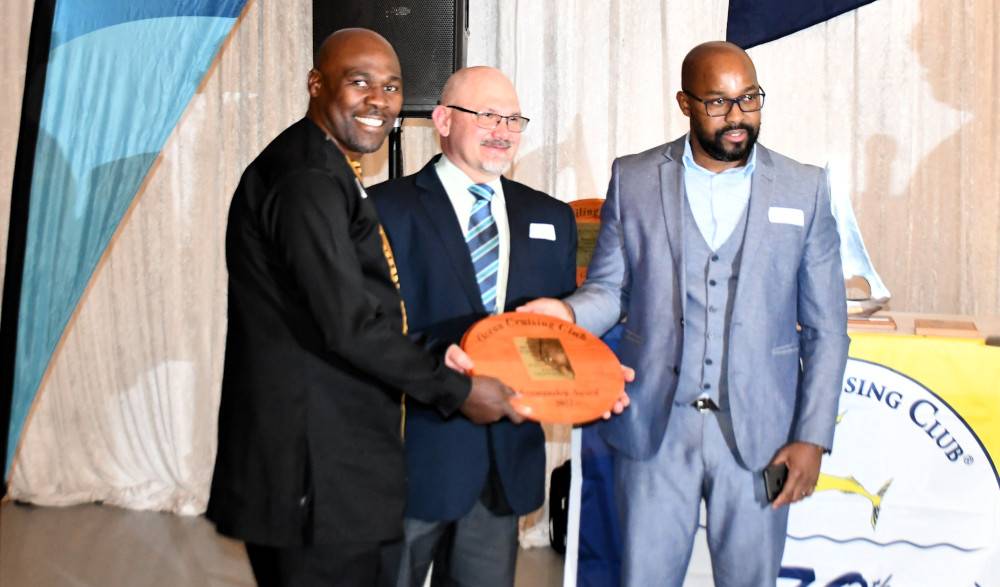
A few seconds later, with the two representatives of the Maritime Rescue Coordinating Centre, Acting Chief Almar Schutte and Duty Operator Donald Ratshibvumo having gently risen and stood up in the audience in confirmation of their presence, Lehtinen calmly spoke his heartfelt words of deep gratitude.
“ ….Yeah, so, all of you … I owe my life to you! I’m very, very humbled. Thank you!” said Lehtinen as he carefully, slowly lowered forward his upper body in a bow to those before him. And as he did so, the audience rose with him and exploded in a crescendo of clapping hands. The sound reverberated throughout the Regatta Centre and spread across the sea waters abutting the Royal Cape Yacht Club, a few kilometres east of the City of Cape Town.
The early evening joint prize-giving ceremony by the London-based Ocean Cruising Club (OCC) and its local sister, the Ocean Sailing Association of Southern Africa (OSASA), was a joyful moment for all involved. The MRCC was honoured on the occasion with an OCC Seamanship Award for its role in the rescue of Lehtinen on those two harrowing Spring days of November 2022.
Likely lost to some in the audience was that it was the second such call by Lehtinen, directly or indirectly, to the MRCC in a space of a year. The first and decidedly most chilling call he’d made earlier was while he was alone, in distress and at risk of death, in the middle of the Southern oceans, a good 800km from the nearest shore southeast of Gqeberha in the Eastern Cape province of South Africa.
By the OCC’s account of the incident during a Global Golden Race event that had reached Southern Africa’s waters in early Spring 2022: “Tapio Lehtinen’s boat took on water at the stern and sank within five minutes. Tapio set off his EPIRB, donned his survival suit, grabbed his ditch bag, and deployed his life raft just before his Gaia 36 ASTERIA sank.
“He was rescued from the life raft by Kirsten Neuschäfer (who was about 100 miles away at the time of the sinking) and was transferred to a bulk carrier in 3m seas and 25km winds,” said OCC Commodore, Simon Currin.
At the time, the OCC noted that having been alerted to the distress call, MRCC Cape Town confirmed communication with Captain Naveen Kumar Mehrotra onboard the bulk carrier M.V. Darya Gayatri, approximately 50 nautical miles Northwest of Tapio’s position, diverting course at 12,5 knots and rendering assistance with an ETA (estimated time of arrival) between 0830 and 1000 UTC on 19 November, wrote Currin.
The story, told from all angles, boils down to one tiny point: the definition of the part of the role and function of the South African Maritime Safety Authority (SAMSA) Centre for Sea Watch & Response, incorporating the MRCC, located on a hilly and partially tree lined landscape East of Cape Town, overlooking both parts of the Indian Ocean to the Southeast and the Atlantic Ocean to the Southwest, with Table Mountain neatly settled in the middle.
In simple terms, as its name spells it out, the role and function of the CSW&R, working closely with the MRCC and in constant close collaboration with various others in the public and private sectors, locally and abroad, is to maintain effective maritime domain awareness, described by the International Maritime Organization as having an “effective understanding of any activity within the state’s maritime domain that could impact on safety, security, economy and environment,” thus fulfilling the legislated core mandate of SAMSA, to ensure the safety of life and property at sea and protection of the maritime environment; as prescribed in its founding legislation, the South African Maritime Safety Authority, Act 5 of 1998.
The Centre operates 24 hours a day, 365 days of the year, constantly keeping a watchful eye and in contact, when needed, with thousands of vessels, big and small, traversing the three oceans region surrounding South Africa, while serving, at the same time, as the focal point for coordination of emergency medical evacuations from vessels and maintaining the maritime assistance service to those vessels that find themselves in dire need for assistance within South African waters.
This service is coordinated in conjunction with SAMSA operations, legislated to assist the vessels to ports of refuge when circumstances require such intervention. The centre, under its intervention section, also manages the deployment of the country’s emergency towing vessel, tasked with protecting our pristine coastline from potential oil pollution from ships, through emergency response and salvage.
The Head of the SAMSA CSW&R, Capt. Pretty Molefe — the first black South African woman to hold the position — broadly outlined the unit’s role and function both from a domestic and global perspective.
Capt. Molefe says: “At the centre for Sea Watch and Response, maintaining maritime domain awareness is of extreme importance for purposes of ensuring a timely response to incidents developing at sea, including search and rescue.
“South Africa, being signatory to the International Convention on Maritime Search and Rescue adopted by the International Maritime Organization (IMO), has an obligation to respond to distress calls within its designated Search and Rescue Region (SRR).
“This piece of legislation is domesticated by the SASAR Act 44 of 2002, within which falls the South African Search and Rescue Organization. MRCC Cape Town forms a crucial part of the South African Search and Rescue (SASAR) Organization, in that, it is tasked with coordinating all maritime SAR operations within our SAR region — a sizable 27.7 million square kilometres of it!”
Citing the SASAR motto: “Joining hands so others may live…” Capt. Molefe describes cooperation and collaboration with others, both within the public and private sectors, domestically and abroad, as essentially conditional to successful execution of the centre’s role and function.
Such cooperation and collaboration extend to regular engagement with like institutions regionally and globally, such as the International Maritime Organization (IMO) and International Civil Aviation Organization (ICAO) Joint Working Group on Search and Rescue (IMO/ICAO JWG) whose most recent meeting, and the first in Africa, was held over five days in November in Cape Town.
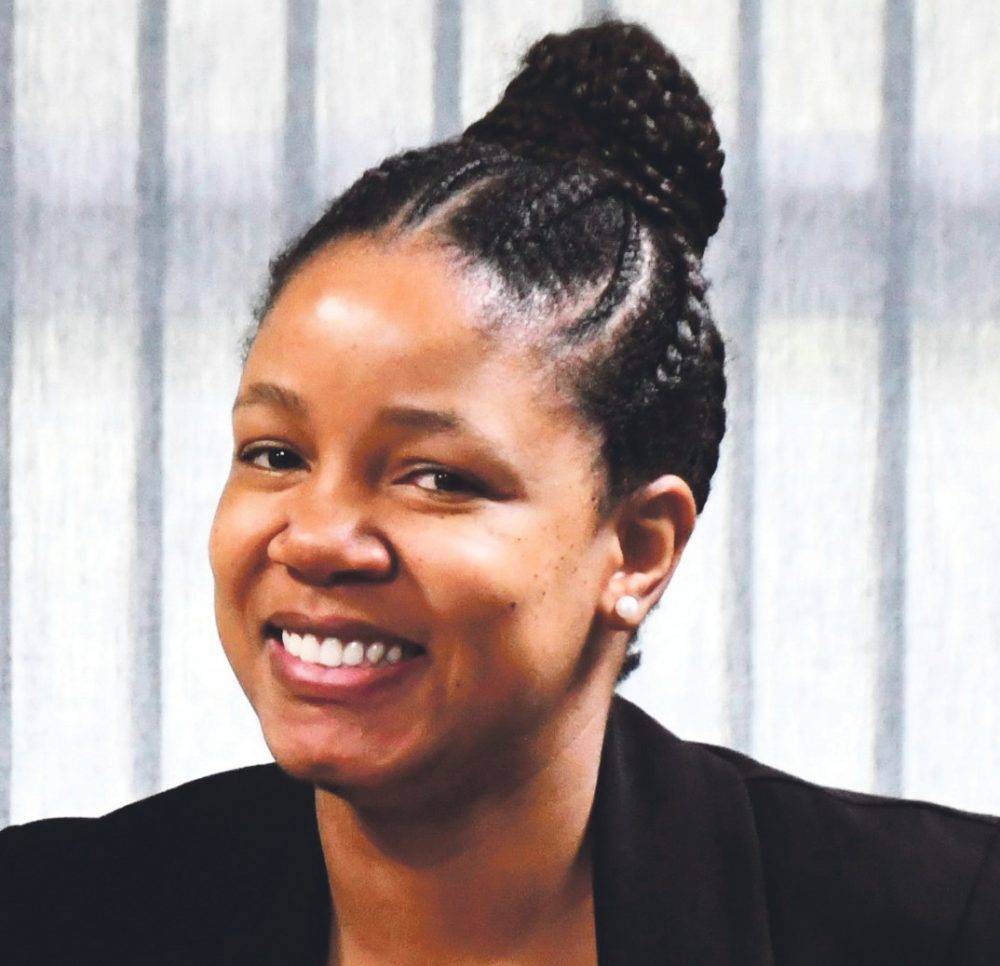
The Centre is also joint responsibility for engaging with and contributing to effective discharge and management of the country’s National Oil Spill Contingency Plan (NOSCP) undertaken jointly with public, private, and non-governmental organisation groupings under the Interim Incident Management Organisation (IMOrg) to which no less than three government departments are involved.
Among others, the centre further serves as a full member of the South West Pacific Data Distribution Region (SWPDDR) through which South Africa and several countries in the region subscribe to the COPSAS SARSAT Programme.
The latter programme is described as essentially a satellite-based search and rescue (SAR) distress-alert detection system made up of satellites in space and infrastructure to receive signals on the ground. Its main function is to facilitate radio transmission at sea via satellites to activate life-threatening emergency support from government authorities. In SWPDDR the system reportedly detects beacons approved for use and operating on the 406Mhz frequency band.
Under the international Convention on Safety of Life at Sea (SOLAS), SAMSA is also the Competent Aids to Navigation Authority and through the CSW&R commands oversight and regulatory function over all marine aids to navigation, coastal and on inland waters to ensure compliance to international conventions, agreements, legislation and standards, both domestic and international.
In keeping up with evolving international trends, inclusive of technological advancements which contribute to, among others, rationalisation of marine aids to navigation through risk analysis, reduction of light ranges, reduction of operational costs, adoption of quality management systems as well as emphasis on environmental management, the centre regularly interacts with like organisations across the world.
Says Capt. Molefe: “The MRCC is manned by a team of men and women who are not only qualified but are equally as dedicated and attentive to each call that is received, whilst maintaining the highest level of professionalism, often under stressful conditions.
“Considering the very treacherous nature of the maritime environment, one would appreciate the fact that it takes teamwork and cooperation to execute and conclude a successful rescue operation, especially upon high seas,” she says, further citing as an example, the “seamanship, demonstrated by skilful sailors such as Kristen Neuschäfer and the crew of the DARYA who played a pivotal role in the rescue of Lehtinen, and [who were] also recognised with awards for it”.
It is a view shared also by the late Jared Blows, who at the time of the incident of the rescue of Lehtinen, was Chief of the MRCC. Blows, who sadly passed away in June 2023, held the view that: “The team at MRCC display professionalism and strives to maintain world-class standards, even under very challenging times.
“Over its almost 20 years being hosted by SAMSA, the MRCC has been involved in numerous incidents, notable among these being the 2011 rescue of 33 Taiwanese sailors about 2000nm west of Cape Town following their vessel having had an onboard explosion and fire, resulting in them needing to abandon the vessel. The Cape to Rio (2014) yacht race rescue incident hours after the race started in very treacherous conditions and more recently, the rescue of 62 sailors after their vessel, GEOSEARCHER (2020), sank off Gough Island,” remarked Blows.
On being publicly acknowledged and recognised recently by the OCC with the Seamanship Award 2022 for the MRCC’s role in the rescue of Lehtinen, Capt. Molefe accepted it with humility. She says: “I commend the MRCC team for their meticulous coordination of this rescue, in cooperation with the Master of the M.V. DARYA and Ms Neuschafer, which resulted in saving a life.
“We are extremely honoured to receive this recognition and such an important award, Seamanship Award 2022, issued by the Ocean Cruising Club. This industry is not one that is short of challenges, but each one strengthens us and makes us better. Ensuring safety of life and property at sea remains imperative for us at the South African Maritime Safety Authority.
Capt. Molefe’s subordinates and teammates, who are often at the thick of things, and were present in person to receive the award on behalf of the MRCC, Schutte and Ratshibvumo, literally sang the song from the same theme in their publicly expressed views.
However, significantly, both were quick to indicate that the unit and centre go about their work daily, throughout the year; with the sole objective of ensuring the safety of people and property at sea. Of the public recognition and acknowledgment, they also both welcomed it.
Inscription on a founding plague at the MRCC with the visual of a ship in trouble in stormy seas
“The water off South Africa and the other countries in this region have more than often shown their inhospitable face, causing many disasters, to the detriment of shipping, the loss of precious human lives and the destruction of the marine environment.
Yours is a very heavy duty and burden and, while I am sure, you will shoulder your responsibilities with commitment, dedication, zeal and enthusiasm, I have some words of advice to share to you. Never be complacent, never allow routine and boredom to impair your actions and decisions, never underestimate the seriousness of any distress incident you handle and never consider any incident to be the same as others you dealt with in the past – because each has its own peculiarities and special characteristics that demand special attention.
Remain focused and, every time you coordinate a SAR operation, give your undivided attention to the task in hand. Never forget that you represent the lost hope of those seafarers for whom fate has in store the better experience of a shipwreck. You will be the first they will thank once rescued and safe on solid ground, and you will have their eternal gratitude and that of their families.
I wish you every success and good luck in the discharge of your important responsibilities. We are proud of you.
Secretary General of the IMO, Admiral Etthimios Metropoulos
16 January 2007
Maintaining a global standard of maritime sector education and training without compromise
South Africa has a system of training its seafarers that meets the requirements of the STCW Convention
It was a year ago, in November 2023, that South Africa’s maritime sector sighed with great relief and celebrated after a formal confirmation that the country had retained its stature as a global authority in maritime sector education in terms of the International Maritime Organisation’s (IMO) International Convention on Standards of Training, Certification and Watchkeeping (STCW Convention).
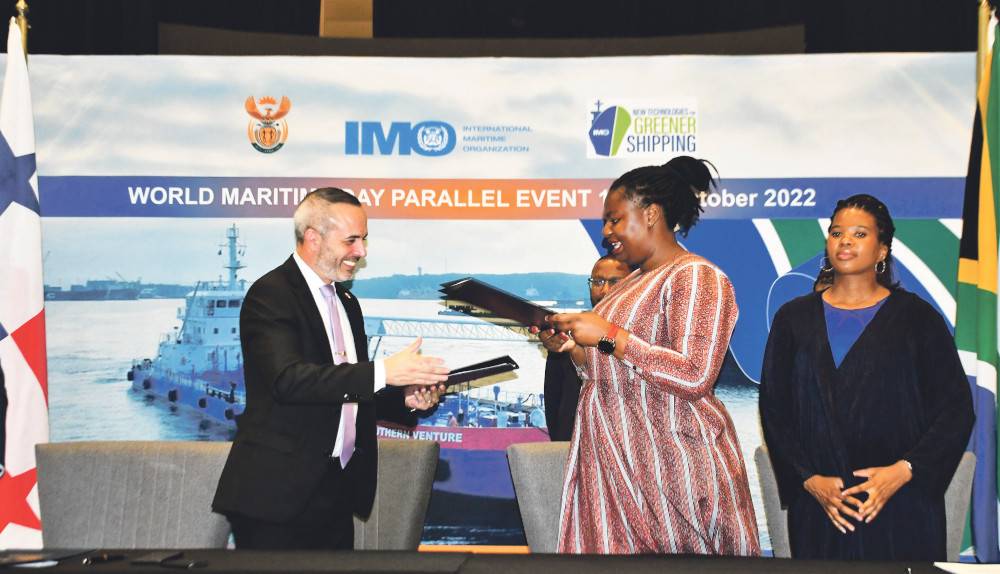
The IMO’s 1978 STCW Convention stipulates standards of training, certification and watch-keeping for seafarers. According to the IMO: “The main purpose of the Convention is to promote safety of life and property at sea and the protection of the marine environment by establishing in common agreement international standards of training, certification and watchkeeping for seafarers”.
The IMO’s secretariat maintains a list (the so-called “Whitelist”) of countries that have demonstrated that they have given and continue to give “full and complete effect” to the STCW Convention. The STCW Whitelist is a testament that the country, through its administration, has a system of training its seafarers that meets the requirements of the STCW Convention. This is achieved by the Parties to the STCW Convention by undergoing an Independent Evaluation, a report of which is evaluated by a panel appointed by the IMO’s secretariat, to report to the IMO’s SG.
For a considerable period, South Africa had to subject itself to the scrutiny of the independent evaluation of its seafarers’ education and training administration in terms of the STCW requirements, but in November 2022, it received the good news that it had passed the audit.
The report of the audit’s positive outcome for South Africa by the IMO’s Secretary General Kitack Lim to the IMO’s Maritime Safety Committee, sitting in its 106th session held in London on 31 October 2022, literally meant that Certificates issued by South Africa to the country’s, including those from neighbouring SADC countries, seafarers spread across the world would retain their full validity status.
The IMO audit verdict delivered in London stated that:
“The Secretary-General of the International Maritime Organization, having solicited and taken into account the views expressed by competent persons, selected from the list established pursuant to section A-I/7, paragraph 7 of the Seafarers’ Training, Certification and Watchkeeping (STCW) Code, reports that the Government of South Africa, Party to the International Convention on Standards of Training, Certification and Watchkeeping for Seafarers (STCW), 1978, has communicated information as required by regulation I/8, paragraph 3 of the Convention (2nd cycle report) and section A-I/7, paragraphs 4 to 6 of the Code, and that the information considered by the competent persons referred to in section A-I/7, paragraph 7 of the Code has demonstrated that full and complete effect is given by South Africa to the provisions of the 1978 STCW Convention.”
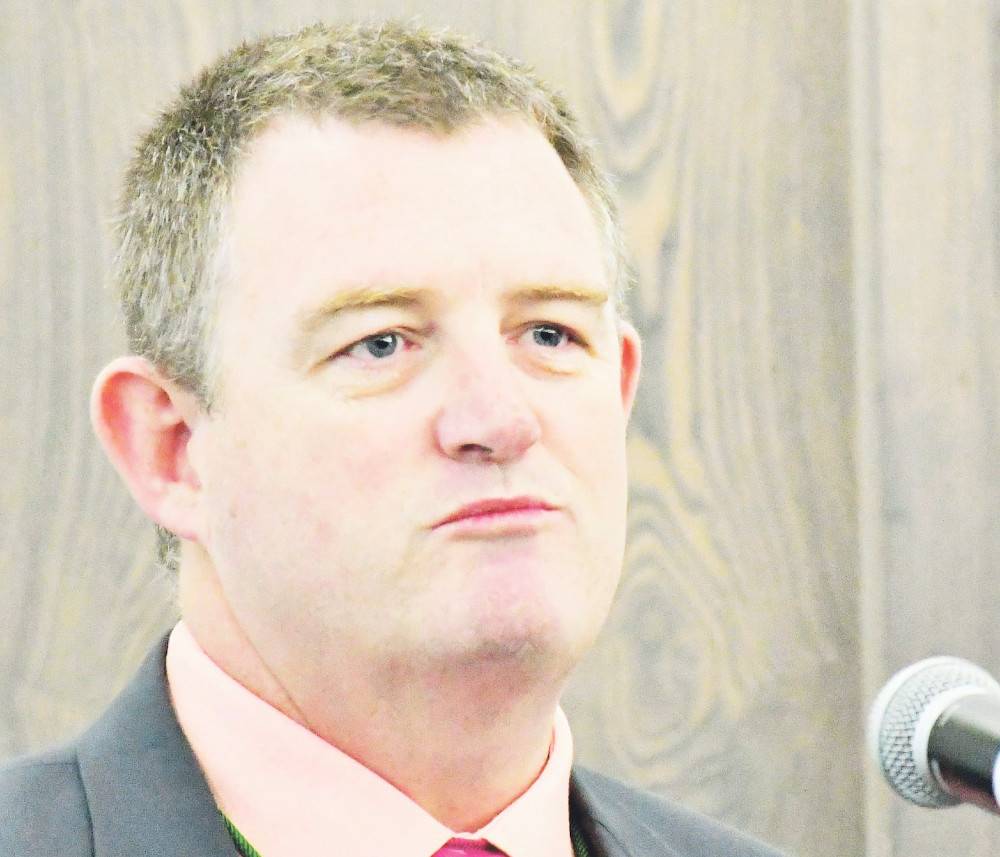
Admittedly, at the time, far more relieved than most was the South African Maritime Safety Authority (SAMSA), a State agency under the Department of Transport (DoT) responsible for the management and administration of seafarer education and training in terms of the STCW Convention, as it is also for keeping a register of seafarers.
SAMSA’s Deputy Chief Operations Officer, Captain Vernon Keller, had personally travelled to London to receive and welcome the IMO Panel’s evaluation outcome and later expressed delight about the verdict, describing it as the “best news for South Africa, SAMSA, the seafarer and general maritime sector community in a while”.
This was in reference to the Panel’s report of South Africa on aspects of the STCW Convention relating to among others, convention regulations to be met inclusive of the STCW Code, and evaluation involving implementation measures and monitoring and compliance measures.
Capt. Keller said: “It is with great privilege to announce today that South Africa officially passed our IMO STCW Audit as assessed by a panel of experts [sic, panel of competent persons]. Our having successfully met and satisfied the IMO STCW Convention evaluation requirements means that we, as South Africa, give full and complete effect to the STCW convention.
“This also means that the South African STCW Certificate of Competence remains recognised internationally, and is in good standing, and therefore South African seafarers and companies do not have to worry about losing their jobs because their CoC’s fall off the Whitelist,” said Capt. Keller.
Extending a word of gratitude to all those who contributed to the achievement both at SAMSA and elsewhere, Capt. Keller said: “As a team, we have all worked hard towards this moment. Despite the many challenges that we faced as an organisation over the last few years, we again proved that through great adversity, only by working together can we achieve great things.
“As South Africa, we can now actively pursue more STCW Regulation 1/10 agreements [MOUs] with other flag states to help create more job opportunities for South African seafarers,” he said.
Also delighted and visibly so was SAMSA Chief Examiner, Azwimmbavhi Nelwamondo, who was simply at a loss of words for the success: “I don’t know what to say — I thought I’d have a speech, but I am speechless. I’m having to think hard about this. As a great man once said, ‘it seems impossible until it is done’.
“I didn’t think doing one’s job could bring so much joy. I am entirely grateful to the team that worked alongside me this whole time. The focus and ability they demonstrated has been amazing. The quality of the work they did was amazing. It is testament to their efforts that the Independent Evaluators made no non-conformities against the Quality Standards System we have built.”
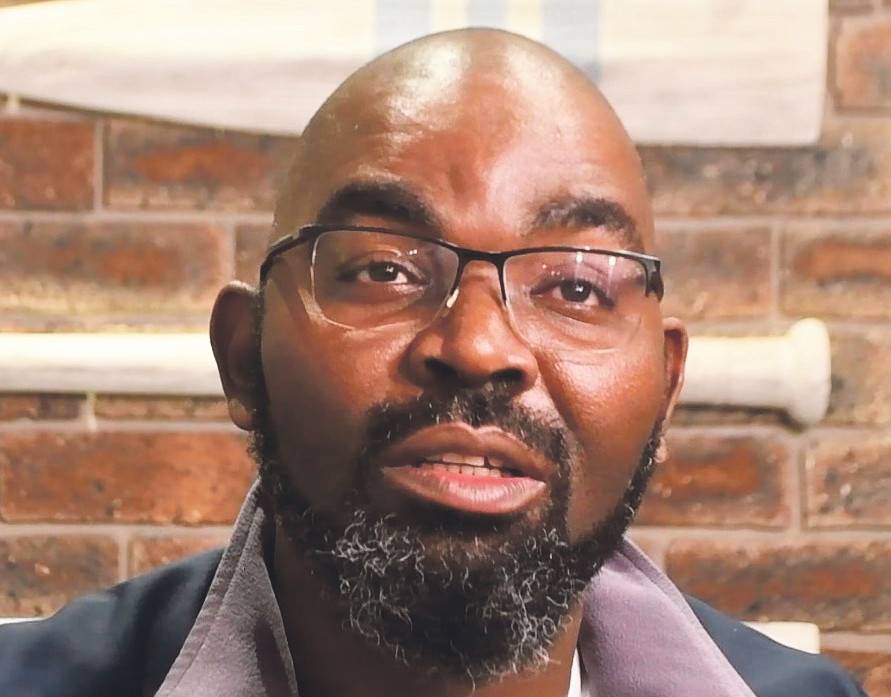
Notably, it is highly significant that since that period, South Africa has signed a series of Memoranda of Understanding (MoUs) with a few countries relating to the mutual recognition of seafarers’ certificates.
The first of several countries to sign MoUs on seafarers’ certification recognition with South Africa within a short time of the IMO announcement were Ghana and Panama, who did so during the inaugural staging on African soil of the IMO’s World Maritime Day Parallel Event (WMDPE) attended by delegates of its 175 Member States in Durban last year.
Of similarly high significance is that South Africa has since also had its maritime sector education and training syllabus committee reconstituted and re-established under a revised Constitution and a Code of Conduct. The 37-member strong committee with notable enhanced inclusiveness, was relaunched with the maritime sector industry support and applause in Durban in July 2023.
Broadly, according to Nelwamondo, the Syllabus Committee’s role is focused three aspects: the development, reviewal and maintenance of the training and assessment standards for seafarers through the Training Standards Code, development, and submission of proposals for consideration amendment of Regulations, and the identification and channelling to the SAMSA of any other matters relating to the training, assessment and certification of seafarers, raised by members of the public.
The post SAMSA’s 25 Year Anniversary: Section Two appeared first on The Mail & Guardian.
South Africa also rises to the helm of the Djibouti Code of Conduct-Jeddah Amendment over the next two years
The post SAMSA’s 25 Year Anniversary: Section Two appeared first on The Mail & Guardian.





